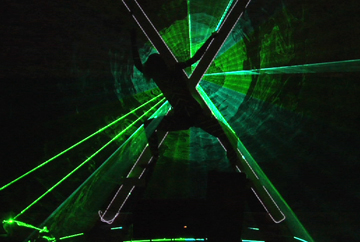There is no question that the Internet is transforming the way we experience art. A few weeks ago, Art21 tweeted that data released by the NEA indicates that visits to museums and galleries are declining, while more and more people are experiencing art through electronic media. Though the World Wide Web has the potential to bring art to larger and broader audiences, encountering an artwork virtually is significantly different than viewing the “original” in person. But what about work that is made specifically for the Internet?
This year marked the birth of the first Internet Pavilion at the Venice Biennale. Conceived by Greek-born artist Miltos Manetas, it is the only pavilion in the 53rd International Art Exhibition that can be directly experienced by any reader of this blog, or almost any individual with online access. Generally classified as “Internet art,” the artworks featured in the Internet Pavilion engage with the World Wide Web in various ways, approaching it as a medium, an exhibition space, and a subject.
Although the Internet Pavilion has a “physical outlet” in Venice, this real world exhibition space seems to function for the Pavilion in the same way that a portfolio website might function for an artist working in more traditional media. During the Biennale’s opening week, the space (located at S.A.L.E, Magazzini del Sale, Zattere) housed a powerful performance by AIDS-3D and Helga Wretman, as well as various subversive happenings by filesharing pioneers/outlaws/activists The Pirate Bay. However, the works that are still on display—a new work by Aleksandra Domanović, a sculpture by architect Christian Wassman, and projected videos from the New Wave online exhibition–feel like shadows of their online selves. Rather than an autonomous exhibition, the embodiment of the Internet Pavilion in Venice serves as a signpost, directing attendees of the Biennale to…well, the Internet part of the Internet Pavilion.
Moreover, national pavilions in the Biennale do not simply exhibit works of art. Rather, each artist also serves a symbolic function, with the goal of embodying, in some way, his or her respective country as a whole. Likewise, Manetas chose the components of the Internet Pavilion as a vehicle to represent the Internet as an entity, a space, a reality. He expanded on this idea, and his overall vision for the Internet Pavilion, in an interview following the Biennale’s opening events in Venice.
Lily Simonson: In its present incarnation, the Internet Pavilion has many participants/ingredients: New Wave show, the Pirate Bay, AIDS-3D, Wikipedia Art Embassy, and more. How did you select the participating artists?
Miltos Manetas: I was thinking of the Chorus in the Greek Tragedy, the power of Chorus, the dynamics of its eventual complaints or its approval. Finally, I choose to let on stage—as the only actor—the Internet itself. In this sense, the Internet Pavilion is a monologue in front of a Chorus, the fragmented talk of the Internets while the artists, the architect, the composers, the designers, and the activists I invited are making noise in the background.
LS: Some of the rhetoric surrounding the Internet Pavilion likens the Internet to a country. Also in your essay, “Websites Are the Art of Our Times,” you write that the Internet is “a ‘space,’ similar to the American Continent immediately after it was discovered…” Now in 2009, are we still just explorers of the Internet, or do you think that it is possible to be from the Internet, the way you can be from Greece or from the United States?
MM: Yes, now we can be “from the Internets”—that’s the point of the project. It was President Bush who coined that term: in his…imagination, the Internet multiplied exactly like the bread and the wine produced by Jesus in the desert. President Bush gave us a hint: we know now that the “Internets” are what these people fear. Sooner or later, their Cyclopic hate will break upon us; there will be laws and tech that will aim to censure the Net.
LS: I am most curious about the inclusion of the Pirate Bay, since they are artists, politicians, and outlaws. What brought about your collaboration with them?
MM: I consider the matter of intellectual property and copyright a very important one. People tend to think of it as just some Hollywood and Silicon Valley bosses losing money and the rest of us getting something for free but that’s just for beginners. The fact is that the world is becoming digital, that the texture of knowledge is one you have to copy. The producers of copyrighted material, like ourselves, are simply too few to dictate the rules of this game. Everything that becomes successful, from a poem to a drug, owes its success to the manipulation of masses. People haven’t asked to know how the Coca Cola logo looks, neither have they asked to know the melody of Like a Virgin. People, the multitude, should own anything that’s projected on them. The Pirate Bay are working on all this and much more in a peculiar way—with humor, with beauty. They play their social video game so well that they have even won a seat in the European Parliament.
LS: What is your vision for the interactive piece of the Internet Pavilion, the StupidForum?
MM: Think of the StupidForum as a beach, a large sandy beach where you can write things and then the wave comes and erases them—the wave of all the others who are passing from the website.






Pingback: Baldessari 2.0: Jumping the Lobster | Art21 Blog